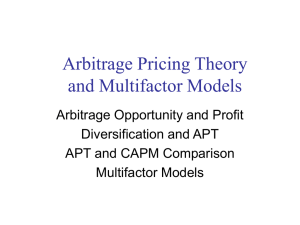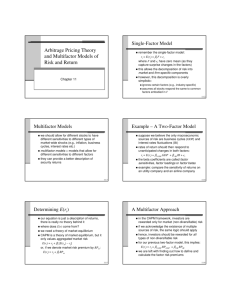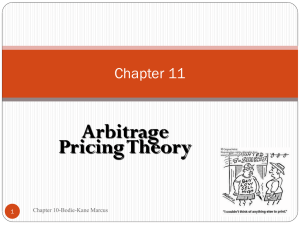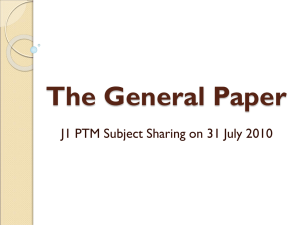Chap010 - revised
advertisement
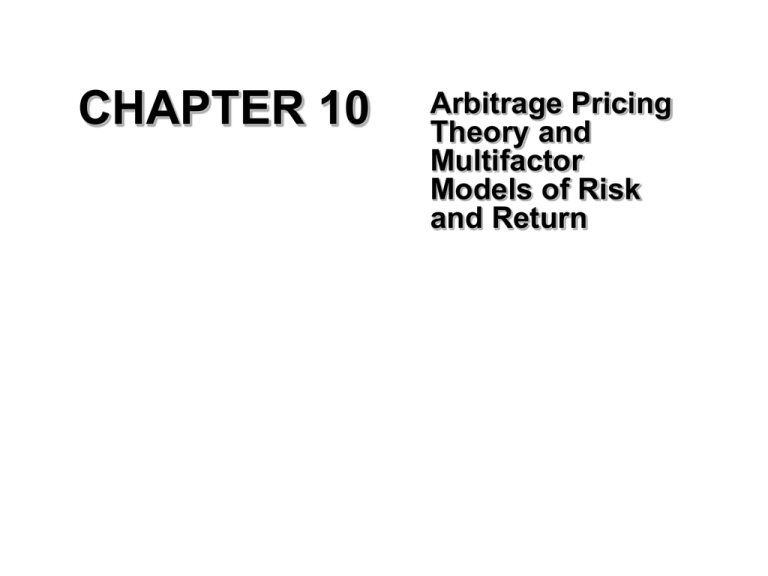
CHAPTER 10 Arbitrage Pricing Theory and Multifactor Models of Risk and Return Single Factor Model • Returns on a security come from two sources – Common macro-economic factor – Firm specific events • Possible common macro-economic factors – Gross Domestic Product Growth – Interest Rates 10-2 Single-Factor Model r i = αi + β i f + e i , ri = stock i’s return f = a macro economic factor βi = sensitivity of stock i’s return to the macro economic factor ei = return component due to stock specific events 10-3 Single-Factor Model in Alternate Form (1) ri = αi + βi f + ei , Taking expectation of (1), we have (2) E(ri)= E(αi + βi f + ei) = αi + βi E(f) Subtract (2) from (1) ri - E(ri) = βi f - βi E(f) + ei = βi [f - E(f)] + ei ri = E(ri) + βi [f - E(f)] + ei (10.1) ri = E(ri) + βi F + ei 10-4 Single Factor Model Equation ri E (ri ) i F ei ri = Return for security i βi = Factor sensitivity or factor loading or factor beta F = Surprise in macro-economic factor (F could be positive, negative or zero) ei = Firm specific events 10-5 Multifactor Models • Use more than one factor in addition to market return – Examples include gross domestic product, expected inflation, interest rates etc. – Estimate a beta or factor loading for each factor using multiple regression. 10-6 Multifactor Model Equation ri = E(ri) + iGDP GDP + i IR IR + ei ri = Return for security i i GDP= Factor sensitivity for GDP iIR = Factor sensitivity for Interest Rate ei = Firm specific events 10-7 Multifactor SML Models E(r) = rf + iGDPRPGDP + iIRRPIR = Factor sensitivity for GDP GDP i RPGDP = Risk premium for GDP i IR = Factor sensitivity for Interest Rate RPIR = Risk premium for Interest Rate 10-8 Arbitrage Pricing Theory Arbitrage - arises if an investor can construct a zero investment portfolio with a sure profit • Since no investment is required, an investor can create large positions to secure large levels of profit • In efficient markets, profitable arbitrage opportunities will quickly disappear 10-9 APT & Well-Diversified Portfolios rP = E (rP) + PF + eP F = some factor • For a well-diversified portfolio: eP approaches zero Similar to CAPM, 10-10 Figure 10.1 Returns as a Function of the Systematic Factor 10-11 Figure 10.2 Returns as a Function of the Systematic Factor: An Arbitrage Opportunity 10-12 Figure 10.3 An Arbitrage Opportunity 10-13 Figure 10.4 The Security Market Line 10-14 APT and CAPM Compared • APT applies to well diversified portfolios and not necessarily to individual stocks • With APT it is possible for some individual stocks to be mispriced - not lie on the SML • APT is more general in that it gets to an expected return and beta relationship without the assumption of the market portfolio • APT can be extended to multifactor models 10-15 Multifactor APT • Use of more than a single factor • Requires formation of factor portfolios • What factors? – Factors that are important to performance of the general economy – Fama-French Three Factor Model 10-16 Two-Factor Model ri E (ri ) i1F1 i 2 F2 ei • The multifactor APR is similar to the onefactor case – But need to think in terms of a factor portfolio • Well-diversified • Beta of 1 for one factor • Beta of 0 for any other 10-17 Example of the Multifactor Approach • Work of Chen, Roll, and Ross – Chose a set of factors based on the ability of the factors to paint a broad picture of the macro-economy 10-18 Another Example: Fama-French Three-Factor Model • The factors chosen are variables that on past evidence seem to predict average returns well and may capture the risk premiums rit i iM RMt iSMB SMBt iHML HMLt eit • Where: – SMB = Small Minus Big, i.e., the return of a portfolio of small stocks in excess of the return on a portfolio of large stocks – HML = High Minus Low, i.e., the return of a portfolio of stocks with a high book to-market ratio in excess of the return on a portfolio of stocks with a low book-to-market ratio 10-19 The Multifactor CAPM and the APM • A multi-index CAPM will inherit its risk factors from sources of risk that a broad group of investors deem important enough to hedge • The APT is largely silent on where to look for priced sources of risk 10-20
